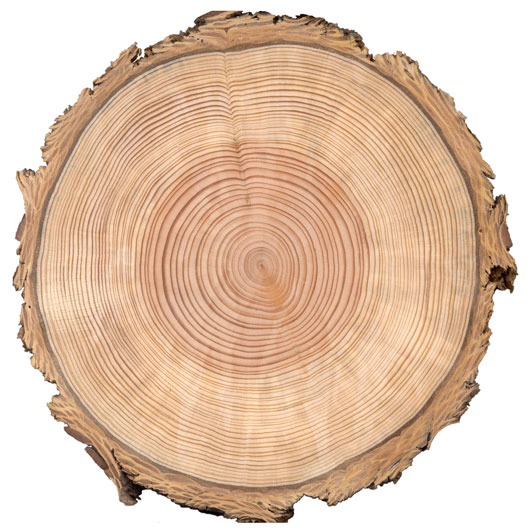Here’s a quick guide for you to read before you head to the lumber yard – learn how to choose the right wood for the right application when you’re building an electric guitar. This article covers all you need to know about the different cuts of wood you’ll come across and how you can identify them by their grain patterns, as well as their suitability for applications within lutherie.
Every piece plank of processed wood starts off with a single cut, not unlike the example pictured here. From there, the log is going to be divided into sections using three different cutting techniques: quarter-sawing, flat-sawing (or plain-sawing), and rift-sawing. Each of these cut types has its own qualities, price ranges, consistencies, and even their own trademark warping patterns.

The right side of the image I’ve prepared below [Example 1] is the best example of how a tree might be processed to accommodate for all three types, but it doesn’t mean that some trees aren’t run through the saw mills to be divided by only one type of cut. This is notable because the amount of waste a particular cut type makes will drive the price up – flat-sawn wood is the least wasteful (imagine the log section with a bunch of horizontal lines on it) while rift-sawn wood is the most wasteful type of cut.
Quarter-sawn wood is somewhere in between, thankfully, since it’s the most useful type for our purposes. Why is that, you ask? Because it happens to be the most durable and consistent of the three with the least amount of lateral shrinkage and, most importantly, the least prone to warping deformities that would render a guitar neck entirely useless. Make note of each of the cuts’ grain patterns in the digram above [Example 2].
If you were to forget everything you know about wood and have to make a decision on what type of wood cut to select for a guitar neck based on the image above, which do you think would be the best choice? You can lay a fretboard over the quarter-sawn example there and be confident that your playing won’t be terribly affected even if the wood decides to bulge outward over time. If you look at the end of any bolt-on neck, you’re most likely to see the grains running perpendicular to the fretboard, somewhere near a 90° angle. There is a general range for the angle at which the grain patterns run on each cut, which I’ve highlighted in red here.
- Plain-Sawn – 0-30° from face
- Rift-Sawn – 30-60° from face
- Quarter-Sawn – 60-90° from face
Does that make plain-sawn wood the worst choice?
In my opinion, yes. For necks at least. If that statement has infuriated you, then I’m happy to square up over it. Plain-sawn wood has been used in a few vintage guitar necks, and some people claim that the tone is different…I entertain a lot of things regarding tonal qualities of guitar parts, but this is not one of them. I don’t even want to dignify it.
For those who say that the fretboard would act as a laminate and prevent the cupping deformities we see in the image, I’m pleased you’re taking a more sound route with your argument. If I have the choice though, I’m going to take the least amount of risk possible in my guitar’s neck strength and stability. If you’re going to say that a modern dual-action truss rod will hold any cut of wood straight and be able to counter any amount of vertical warping, the answer is still going to be “not worth the risk”.
So, quarter-sawn wood is without a doubt the best selection you can make for your guitar’s neck. To further guarantee its stability, you can bookmatch the cut you’ve chosen to create a perfectly symmetrical grain pattern:
The process simply involved cutting a piece of wood down the middle and flipping it. This is going to increase the strength tremendously, as well as helping prevent against future warping. In the event of the wood deciding to fight against you, at least the warping that may occur will at least happen in such a way that doesn’t affect each side of the fretboard differently, and will be slightly easier to combat.
If you’re worried about the grain pattern being ruined by the cut, you’re not likely to ever notice it if you’ve glued and clamped the pieces properly, since a quarter-sawn grain is going to be running parallel to the cut.
Speaking of clamping and neck grains, there’s also the option of laminating multiple pieces of wood for an exponential increase in strength:
This will give you some fun options when it comes to your guitar’s appearance (Carvin has always had excellent taste when it comes to neck laminates and natural finish). Not to mention, you won’t have to fear too much if the quarter-sawn slab you bought might be hovering a degree or two less than the aforementioned ranges suggest. It’s gonna be fine.
Wood Figuring Dependent on Cuts
After that minor ramble about quarter-sawn wood being the most stable, you’re probably wondering if there’s reason to use any other type. And there is, preferably on the body though (and if you’re going all out and doing the knobs as well). Plain-sawn wood tends to be the most revealing when it comes to figuring. There’s about a billion different names floating around for each of the various types of figuring, and I find each one as impressive as the next when you see them being used by luthiers. You can find a ton of guitars with a top made of flamed maple veneer, but not too many other variations seem to be used in mass manufacturing – likely due to availability and pattern consistency more-so than cost. You’ll find lot of really great luthiers who focus on using more varied figuring & exotic woods as a mainstay in their work, and that’s one of the main appeals of buying a custom-built guitar.
I’ve put together a collage to display the broad spectrum of different wood figures and patterns and done my best to include the terms that are most popular and can serve as a blanket name to consolidate the many similar subtypes of a single pattern (as I said before, the number of names put to each pattern is annoyingly high, and some of them are just stupid – particularly when there’s already a much more appropriate name):
Would you believe that almost half (4/9) of those figures are only possible when the wood is plain-sawn? This is why you don’t see many guitars that feature the same figuring on the body and the neck. You have a much wider variety of woods and patterns to choose from when it comes to building your body simply because flat-sawn pieces are suitable here (less if you subscribe to the idea that body wood having a profound effect on your tone). As long as the wood has been properly cured, I don’t see the cut type limiting you too much. This is especially true for anyone who decides to incorporate multiple woods by laminating a top-wood veneer. This will allow you to get the most aesthetically pleasing results while maintaining the strength and stability of another species/cut (and tonal qualities, again if that’s a concern of yours).
Figured veneering is extremely popular, so it’s not too difficult to find – this is one way you can get the best of both worlds; the desired aesthetic qualities of a flat-sawn piece and stability of a quarter-sawn slab below. But veneering isn’t going to work for necks so well – I’ve seen it done, but it’s going to be a fair amount of extra work for you. Luckily, maple wood and all of its many subspecies are likely to produce some sort of curling or quilting figure no matter which way you slice it (still, certain patterns are only achievable with plain-sawing). Maple, being one of the core wood types in neck construction, will often produce figured results without your intention – like this telecaster neck below, for instance:
You can see the tiger stripes running perpendicular to the grain of this quarter-sawn piece of maple – a happy accident. You can continue reading the wood figuring article to get a proper explanation of an extremely interesting topic, and of particular importance to luthiers and electric guitar enthusiasts alike.
I think that should cover most of everything to be said about cut selection, in a general sense…there’s more to be said for cutting particular species, but we’re not focusing on one particular type for this article. For now, I’d say you’re much better prepared to go to the lumber mill than ten minutes ago.
